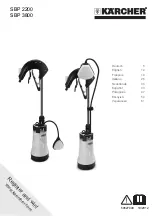
E-6
English
8
8 Start-up
8.1 General
To ensure that start-up is performed correctly, it should only be
carried out by an after-sales service technician authorised by the
manufacturer. This may be a condition for extending the guaran-
tee. (see warranty service)
8.2 Preparation
Prior to commissioning, the following items need to be checked:
All connections of the heat pump must have been made as
described in Chapter 7.
The heat source system and the heating circuit must have
been filled and checked.
The strainer must have been fitted in the well water inlet of
the heat pump.
In the well water and heating circuits all valves that might im-
pair the proper flow must be open.
The settings of the heat pump controller must be adapted to
the heating installation in accordance with the instructions
contained in the controller's operating manual.
8.3 Procedure
The start-up of the heat pump is effected via the heat pump con-
troller.
ATTENTION!
Commissioning is to be effected in accordance with the installation and
operating manual of the heat pump controller.
Where an overflow valve is fitted to assure the minimum heating
water flow rate, the valve must be set in accordance with the re-
quirements of the heating installation. An incorrect setting may
result in various error symptoms and an increased elec-tric
power consumption. To correctly set the overflow valve, the fol-
lowing procedure is recommended:
Close all of the heating circuits which may also be closed during
operation (depending on the type of heat pump usage) so that
the least favourable operating state – with respect to the water
flow rate – is achieved. Normally, these heating circuits are those
of the rooms located on the south and west sides of buildings. At
least one heating circuit must remain open (e.g. bathroom).
The overflow valve is to be opened to such an extent that based
on the current heat source temperature the maximum tempera-
ture difference between heating supply and return flow tempera-
ture is obtained, as indicated in the table below. The temperature
difference should be measured as closely to the heat pump as
possible. In mono-energetic systems, the electric heating ele-
ment is to be deactivated.
Any malfunctions occurring during operation are displayed on the
heat pump controller and can be corrected as described in the
operating manual of the heat pump controller.
9 Cleaning / maintenance
9.1 Maintenance
The heat pump is maintenance-free. To prevent malfunctions
due to sediments in the heat exchangers, care must be taken
that no im-purities can enter the heat source system and the
heating installation. In the event that operating malfunctions due
to contamination occur nevertheless, the system should be
cleaned as described below.
9.2 Cleaning the heating system
The ingress of oxygen into the heating water circuit may result in
the formation of oxidation products (rust), particularly if steel
components are used. They enter the heating system via the
valves, the circulating pumps and/or plastic pipes. It is therefore
essential - in particular with respect to the entire pipework - that
only diffusion-resistant materials are used.
ATTENTION!
We recommend the installation of a suitable corrosion protection system
to prevent the formation of deposits (e.g. rust) in the condenser of the
heat pump. We recommend equipping diffusion-open heating systems
with an electrophysical anti-corrosion system (e.g. ELYSATOR system).
Residue from lubricants and sealants may also contaminate the
heating water.
In the case of severe contamination leading to a reduction in the
performance of the liquefier in the heat pump, the system must
be cleaned by a heating technician.
Based on current information, we recommend using a 5% phos-
phoric acid solution for cleaning purposes. However, if cleaning
needs to be performed more frequently, a 5% formic acid solu-
tion should be used.
In either case, the cleaning fluid should be at room temperature.
We recommend flushing the heat exchanger in the direction op-
posite to the normal flow direction.
To prevent acidic cleaning agents from entering the heating sys-
tem circuit, we recommend connecting the flushing device di-
rectly to the flow and return of the liquefier of the heat pump.
It is then important that the system be thoroughly flushed using
appropriate neutralising agents to prevent any damage from
being caused by cleaning agent residue remaining in the system.
Acids must be used with care and the regulations of the employ-
ers’ liability insurance associations must be adhered to.
In case of doubt, consult the manufacturer of the cleaning
agents!
Heat source
temperature
max. difference between heating
supply and return temperature
from
to
7° C
12° C
10 K
13° C
18° C
11 K
19° C
25° C
12 K
Summary of Contents for WI 100TU
Page 2: ......
Page 22: ...E 10 English 12...
Page 32: ...F 10 Fran ais 12...
Page 55: ...www dimplex de A XXIII Anhang Appendix Annexes 6...
















































